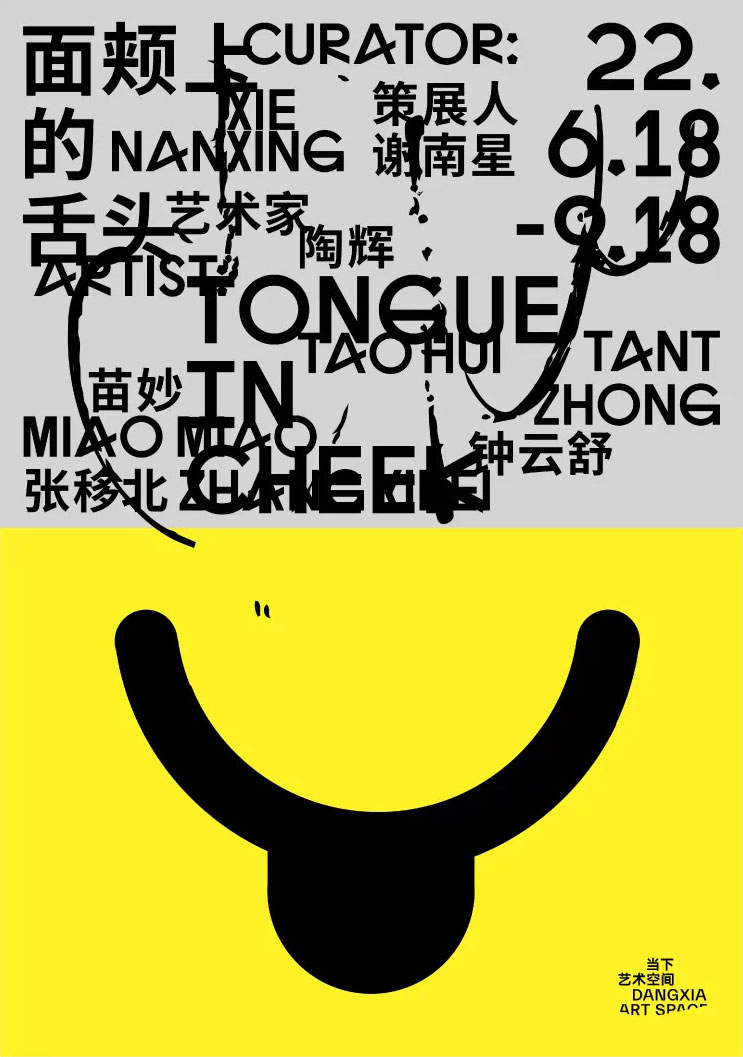DANGXIA Art Space is pleased to announce its official opening of the group exhibition “Tongue in Cheek” on June 18, 2022, at Blanc International Contemporary Art Space, located at Building D7 at the National Foreign Culture Trade Base, inside the Tianzhu Comprehensive Free Trade Zone in Beijing. Artist Xie Nanxing invites four artists – Miao Miao, Tao Hui, Zhang Yibei, and Zhong Yunshu – to present their latest works, which span various media such as sculpture, painting, installation and video, to explore each artist’s unique practice that transcribe invisible inner dialogues into concrete forms.
The concept of With My Tongue in My Cheek was proposed by artist Xie Nanxing and shares its title with a self-portrait created by Henri-Robert-Marcel Duchamp in 1959. In the original work, an exaggerated plaster relief is juxtaposed next to sketched outline of Duchamp’s face, the missing tongue evokes an absence in the outline, which gives the illusion of swelling of the cheeks. Painting and sculpture, as two distinctive artistic media, are superimposed in the same work. The title and the work form a pun, which renders a literal reading impossible.
According to Xie Nanxing, the portrait highlights an important element of the Duchamp’s corpus – to transcribe, and to give form to the unutterable in a visible language. In the process of creation, an artist is often isolated in the studio for prolonged periods. Despite a lack of movement in the physical sense, the artist’s thoughts and emotions are always engaged in dynamic fluctuations, which can even divide into multiple personas. The artist’s work is a deductive process starting from the persona, which can be confronted and further extended outwards in a sequence, and finally externalized into works of different appearances.
If the tongue implies the importance of language to the life of the image, constructing a series of contextual frameworks, then the structure captured by an artist’s mediation and materials can also be regarded as a language, exacerbating a certain illusionist impression in the lifelessness and remoteness of is materiality. In this exhibition, the creations of the four artists form an inherent organic connection in the space.
Miao Miao realizes the exploration of presence through painting, exercising self-confrontation in the everyday. She is preoccupied with colour and form, utilizes literary references, and attempts to elucidate concepts in chaos. The process resembles detours exiting on the cross section of mountains, like a cut-off tongue seeking untill the last to devour the spirit.
Tao Hui uses the title 257 to create a three-part work that combines a comic that can be consumed in solitude, a sculpture of three mountain-shaped bodies, and a few digital cards with sound. The number itself has no inherent meaning other than symbolizing a randomly-generated, natural notion of the self. The mapping of the artist’s personal growth is weaved into a “broken” web with fragmented and unindictable information, wrapping his past experience.
Zhang Yibei’s works connect poison bait stations, spring bamboo shoots, lotus roots, quilts, bicycle tires, copper pots, kettles, finned radiators, and underground water supply pipes under the corner of the wall for rodent control. Such readymade objects found in the hidden and exposed makings of urban life are rearranged in the exhibition hall to present the artist’s struggle with hunger. Zhong Yunshu has set up a participatory installation with The Trophy at the End of the Runway. After going through the width of the runway, the process of walking, sprinting, resting, being blocked, asking for help, etc., accompanied by the faintly audible music of “Edelweiss” leads to the ultimate “trophy”. From the artist’s point of view, this can be regarded as a life path, with an easy-to-enter starting point and a dangerous but rewarding end-point. It is up to the audience to choose whether to go all the way or quit halfway.
As Xie Nanxing notes, confrontation of the self is a traditional topic, but it is closely related to everyone. The so-called “interality” will eventually become images and symbols, and “my tongue” will continue to perform life and death, text and image, humour and seriousness that is played out on the cheeks.























